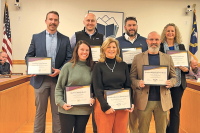Fortunately, the ‘ups’ outweigh the ‘downs’
 Sometimes I forget why I love it so much. The truth is that newspaper work is partly satisfying, partly frustrating. Just ask any of my co-workers.
Sometimes I forget why I love it so much. The truth is that newspaper work is partly satisfying, partly frustrating. Just ask any of my co-workers.
Luckily, the satisfaction that comes from helping a small business gain new customers and find success, from a story well-told, and from making a small difference in the way an important issue is decided is what sticks, making up for many of the frustrations.
While we never do our jobs thinking about awards, having your colleagues recognize that you are doing good work does help keep the flame burning. That happened last week at the N.C. Press Association annual award’s banquet in Chapel Hill, but more on that later.
I got to thinking about the payoffs of journalism when I heard that “Spotlight” won the Academy Award for Best Picture. I immediately wondered how far Hollywood had to resort to its magic to make interesting the story of the Boston Globe’s Pulitzer Prize winning investigation into the Catholic priest sexual molestation scandal.
As a newspaper person for most of my life, I know that much of what we do is very mundane. Most stories, important though they are, aren’t going to win any awards or praise. We still, however, have an obligation to cover them. That’s the business of local news.
The Boston Globe has a proud reputation for being a top-notch local paper, and it touts that “local” legacy. Even though it covers a huge metro area, it does not try to focus on national politics and international stories like the N.Y. Times, Washington Post or Wall Street Journal. It covers its core area, so in many ways it is similar to small newspapers like ours.
Related Items
On Monday, I heard a National Public Radio interview with Walter Robinson, the veteran reporter and editor who led the investigative team — Spotlight — that worked on the sex abuse scandal. Here’s his description of the movie’s depiction of what actually occurred at the newspaper leading up to the publication of the stories:
“Most films about journalism don’t get it right. I’m just delighted, as are my colleagues, that this film just nailed it. What we actually did is so accurately and genuinely portrayed in this film, the reporting steps we took, how making the sausage isn’t always a pleasant task to watch, how reporters disagree with one another, how we stumble around in the dark, how sometimes we find the most important things quite by accident. It’s all there, how we make mistakes in our reporting and how we double back, but always, and certainly in this case, with the mind, ‘We have to get this story, and we have to get it out.’”
Obviously the impact and fallout from this story goes far beyond anything our newspaper has ever reported on. But the internal making of a good story or of working your way through the impediments to getting information are not that different. It’s more like ditch digging — repetitive, like asking the same question, attending another meeting or reading through the same document — than rocket science.
And then there is the presentation of that story. That’s where the designers and art folks on our staff come in, and I know their work is just as critical to the success and impact of a story. It’s all difficult work, and as an editor and publisher I don’t tell our staff how much I appreciate the difficult work they do everyday.
I try to emphasize that in this small newspaper world of writing and designing, every now and then an opportunity comes along that begs for more time, for more creativity, for writing that sings and dances across the page. Recognizing those moments — when you have the opportunity to do something special — is fundamental to putting out a quality paper.
When you have a chance to influence policy, to help a worthwhile cause or give voice to someone who has been treated unjustly, it can’t be rushed. For our newspaper, getting a story right is much more important than breaking a story.
So let’s get back to the recognition for our newspaper at the state contest that was judged by newspaper folks in three other states. The Smoky Mountain News staff took home more awards in the large circulation, non-daily newspaper category than all but one newspaper in the state. Our designers and advertising sales staff won 17 awards (including five first-places) and our reporters won 15 news awards (including six first-places). Among the awards were two for magazines we produce for local organizations: the Haywood County Chamber of Commerce’s magazine, Experience Haywood, and Beverly-Hanks Real Estate’s magazine, Welcome to Western North Carolina, were both winners.
Also of note, SMN won an investigative reporting award in 2015 for its coverage of a bear poaching sting, making this the 12th straight year going back to 2004 that the newspaper has won at least one investigative reporting award (for a complete list of this SMN year’s awards, see the story on page 16).
Call this column a self-indulgence if you will, and I’m OK with that. I don’t say it often, but I take a little pride in what we do. It ain’t easy.
(Scott McLeod can be reached at This email address is being protected from spambots. You need JavaScript enabled to view it.)









